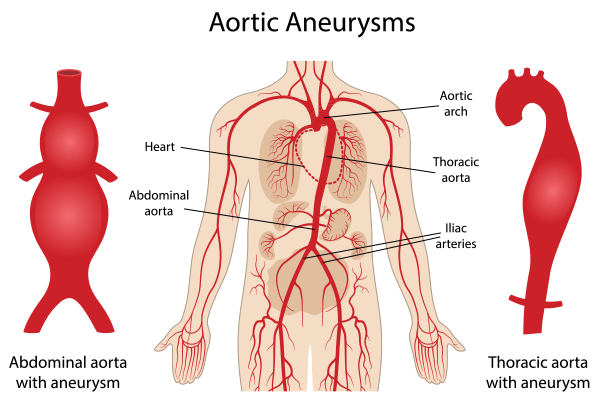
Aneurysms are a silent but potentially life-threatening condition that many people are unaware of until they become serious. Understanding the types of aneurysm, their symptoms, causes, and treatment options can help in early detection and prevention. In this comprehensive guide, we’ll walk you through everything you need to know about aneurysms in an engaging and easy-to-understand manner.
Synopsis
What is an Aneurysm?
An aneurysm is a bulging or ballooning of a blood vessel due to a weakened arterial wall. If left untreated, it can rupture, leading to severe complications such as internal bleeding, stroke, or even death.
Types of Aneurysm
Aneurysms can occur in different parts of the body, and each type has its own set of risks. The most common types of aneurysm include:
1. Abdominal Aortic Aneurysm (AAA)
-
Occurs in the aorta, the main artery carrying blood from the heart to the lower body.
-
More common in men over 60 with a history of smoking or high blood pressure.
-
Symptoms: Often asymptomatic; however, some experience deep pain in the abdomen or back.

2. Thoracic Aortic Aneurysm (TAA)
-
Found in the upper part of the aorta, near the heart.
-
Can be caused by genetic conditions like Marfan syndrome.
-
Symptoms: Chest pain, shortness of breath, difficulty swallowing.
3. Cerebral (Brain) Aneurysm
-
Forms in the blood vessels of the brain and can rupture, leading to a stroke.
-
Often discovered accidentally during imaging for other conditions.
-
Symptoms: Severe headaches, vision problems, loss of balance, difficulty speaking.
4. Peripheral Aneurysm
-
Occurs in arteries other than the aorta, such as those in the legs, arms, or neck.
-
Symptoms: Pain, swelling, and pulsating lumps in the affected area.
5. Ventricular Aneurysm
-
Forms in the heart’s ventricular wall after a heart attack.
-
Symptoms: Chest pain, irregular heartbeat, shortness of breath.
Aneurysm Symptoms
Aneurysms often do not cause symptoms until they grow large or rupture. However, some aneurysm symptoms include:
-
Sudden, severe headaches (for brain aneurysms)
-
Abdominal or back pain (for aortic aneurysms)
-
Chest pain and difficulty breathing (for thoracic aneurysms)
-
Weakness or numbness in limbs (for peripheral aneurysms)
Aneurysm Causes
Several factors contribute to the development of aneurysms. Some of the common aneurysm causes include:
-
High Blood Pressure – Weakens artery walls over time.
-
Smoking – Damages blood vessels and increases the risk.
-
Genetic Conditions – Such as Marfan syndrome or Ehlers-Danlos syndrome.
-
Atherosclerosis (Hardening of Arteries) – This leads to plaque buildup, weakening the artery walls.
-
Infections & Trauma – Rare but can result in aneurysm formation.
Aneurysm Treatment
The aneurysm treatment depends on the location, size, and severity of the aneurysm. Common treatments include:
1. Medication
-
Used to manage blood pressure and cholesterol levels.
-
Helps reduce the risk of aneurysm growth or rupture.
2. Surgical Procedures
-
Open Surgery: The damaged portion of the artery is replaced with a synthetic graft.
-
Endovascular Repair: A less invasive procedure where a stent is placed to reinforce the artery.
3. Lifestyle Changes
-
Quitting smoking, maintaining a healthy diet, and regular exercise can help prevent aneurysms.
Lifestyle Changes for Aneurysm Prevention
An aneurysm occurs when an artery wall weakens, creating a bulge that may rupture. While genetics play a role, healthy lifestyle choices can significantly reduce risk.
1. Diet & Nutrition for Healthy Arteries
-
Eat Omega-3-rich foods (salmon, flaxseeds) to reduce inflammation.
-
Increase fruits & vegetables for antioxidants and fibre.
-
Cut back on processed, salty, and fatty foods to maintain healthy blood pressure.
-
Stay hydrated for optimal blood circulation.
2. Exercise for Prevention
Regular physical activity strengthens arteries and controls blood pressure:
-
Aerobic exercises (walking, cycling) support heart health.
-
Strength training & yoga improve circulation and reduce stress.
-
Consult a doctor before intense workouts if at risk.
3. Stress Management & Heart Health
-
Practice mindfulness & meditation to lower stress hormones.
-
Engage in hobbies & social activities for emotional well-being.
-
Prioritize quality sleep (7-9 hours) to prevent hypertension.
Aneurysm Types & Risk Factors
|
Type of Aneurysm |
Location |
Main Causes |
Symptoms |
|
Abdominal Aortic (AAA) |
Lower aorta |
High blood pressure, smoking |
Abdominal/back pain |
|
Thoracic Aortic (TAA) |
Upper aorta |
Genetic conditions |
Chest pain, shortness of breath |
|
Cerebral (Brain) |
Blood vessels in the brain |
Hypertension, smoking |
Severe headache, vision issues |
|
Peripheral |
Arms, legs, neck |
Atherosclerosis, injury |
Swelling, pulsating lump |
|
Ventricular |
Heart ventricles |
Heart attack |
Irregular heartbeat, chest pain |
Conclusion
Aneurysms can be life-threatening if left undiagnosed or untreated, but early detection and proper management can prevent complications. If you experience symptoms or have risk factors, it’s essential to get checked by specialists.
At Manipal Hospital Gurugram, our expert team of Cardiology specialists provides cutting-edge diagnosis, treatment, and care for aneurysms. Don't wait until it's too late—schedule your consultation today for expert care!
FAQ's
Aneurysms are often found through imaging tests such as CT scans, MRIs, and ultrasounds during routine check-ups.
Small aneurysms can be managed with medication and lifestyle changes. Larger ones may require surgery for complete treatment.
People with high blood pressure, smokers, those with a family history, and individuals with connective tissue disorders are at higher risk.
A ruptured aneurysm leads to life-threatening bleeding, requiring immediate emergency treatment.
Yes, by controlling blood pressure, quitting smoking, maintaining a healthy lifestyle, and undergoing regular check-ups.



















 5 Min Read
5 Min Read

















